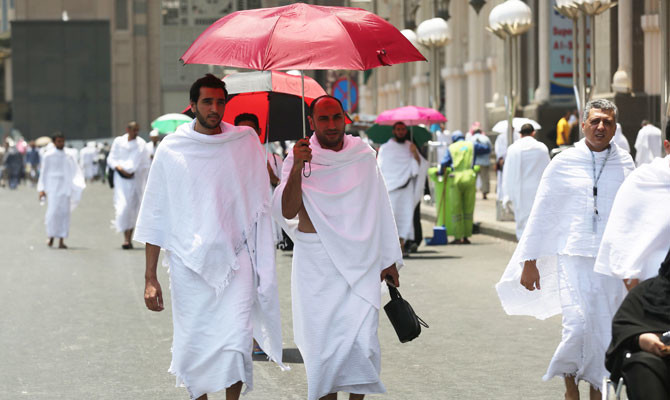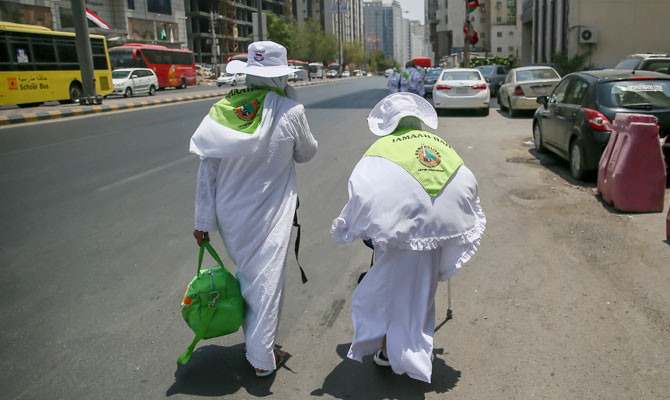The Health Ministry is providing awareness-raising instructions and tips for Hajj on its official website.
These instructions cover chronic diseases, such as advising heart and hypertension patients to see a doctor to make sure they can perform Hajj and carry the right medicines, and ensure that the medicines are properly preserved and consumed, especially during Tawaf which requires great physical effort.
The ministry called on pilgrims potentially at risk of angina pain to consult a doctor about holding sublingual nitroglycerin tablets and using a wheelchair during Tawaf and Sai whenever pilgrims feel exhaustion.
The health instructions also covered diabetics, stressing the need to wear a bracelet or hold an identification card enabling rapid identification of patients with diabetes, have the prescribed medicine, and bring a glucose meter to determine the glucose dose daily.
The ministry highlighted the importance of keeping insulin cool by storing it in a proper ice pack or refrigerator and the need to be given a glucagon injection (when doctors recommend it) in case diabetics are not able to eat or have lost consciousness.
The ministry also advised against performing Tawaf and Sai until after taking medication and eating, stressing the need to stop performing the rituals temporarily in the event of a hypoglycemic episode. Symptoms include shaking and giddiness, along with fatigue and exhaustion, a sudden feeling of hunger, excessive sweating or blurred vision.
The ministry advised asthma patients to consult a doctor, adhere to taking medicines, tablets and inhalers, avoid crowded places, wear a face mask, and consult the nearest health center in case of an asthma attack.
The instructions also covered epileptic patients. Epileptic patients vary in their needs; some can control their illness with medicine and are able to perform Hajj, while patients recently diagnosed with epilepsy are advised to postpone Hajj. Epileptic patients are advised to inform the convoy’s doctor, bring enough medicines, avoid excessive exhaustion and reactions and always be accompanied by friends or relatives during Hajj.
Health Ministry tips for Hajj well-being
Health Ministry tips for Hajj well-being

- Symptoms include shaking and giddiness, along with fatigue and exhaustion, a sudden feeling of hunger
- The ministry advised asthma patients to consult a doctor, adhere to taking medicines
Restoration efforts bring new life to Saudi historic Kasbat Al-Midmar

- The recently restored structure is now preserved under the supervision of Saudi Arabia’s Heritage Commission
RIYADH: In the heart of Badr Al-Janoub governorate, the historic Kasbat Al-Midmar rises proudly from the old district — a striking reminder of Saudi Arabia’s deep architectural and cultural heritage.
Built more than 300 years ago, the kasbah, or watchtower, is a seven-story mudbrick structure designed in the traditional circular form, wide at the base and tapering as it ascends, the Saudi Press Agency reported.
Originally built as a watchtower to safeguard nearby farmlands, it still looks out over the village and valley today.
FASTFACT
Saudi Arabia’s Heritage Commission continues to protect and restore the region’s historic buildings, placing them on the National Antiquities Register as part of the Kingdom’s cultural legacy.
The recently restored structure is now preserved under the supervision of the Kingdom’s Heritage Commission.
Surrounding the kasbah are the remnants of traditional mud houses, part of a network of historical fortresses and homes that reflect the enduring legacy of the region.
These buildings illustrate the ingenuity of local architecture and the importance of such fortifications in the daily life of previous communities.
Manea Naji Al-Saad, vice president of the Najran Society for History and Archaeology, told SPA that the governorate where aware that Badr Al-Janoub is rich in archeological sites, including old mud houses and Qishla Castle, which stands atop Mount Al-Qarah.
Nearby is Al-Thaghr Palace, a structure dating back to the First Saudi State. Built by the order of Imam Saud bin Abdulaziz bin Mohammad in 1221 AH, the four-story palace is made of stone and features a large protective wall and a deep central well.
The commission continues to protect and restore the region’s historic buildings, placing them on the National Antiquities Register as part of the Kingdom’s cultural legacy, the SPA reported.
Research grants to revive Saudi Arabia’s craft heritage

- Program offers funding in six categories to explore how traditional skills sustain culture and economy
RIYADH: Saudi Arabia’s Ministry of Culture, in collaboration with the Heritage Commission, has announced a new research grant initiative to study traditional handicrafts.
As part of the Year of Handicrafts campaign, the program invites scholars to examine how traditional crafts preserve cultural knowledge, embody inherited skills, fulfill social roles, and reflect economic practices that have shaped Saudi society.
The grant covers six research categories to provide insights into handicraft studies. Applications are open until Sept. 1, the Saudi Press Agency reported on Sunday.
Historical research will trace the development of surviving and lost crafts over time, examining how social, economic, and political changes have influenced them.
A second category focuses on craft promotion, investigating initiatives to support and institutionalize traditional handicrafts in contemporary Saudi society.
Economic impact and creative economy studies will analyze how handicrafts contribute to the national economy, including comparisons of domestic and international markets for handmade cultural goods.
Technology integration research explores how modern techniques, design and digital tools intersect with traditional methods to create market-ready products.
Social research will examine community relationships with handicrafts and how cultural perceptions affect the sector’s growth and sustainability.
The final category addresses conceptual frameworks, critically analyzing handicraft terminology, its evolution, and making comparisons with related concepts such as cultural industries, fine arts, and the roles of craftspeople versus artists.
Applicants must hold an advanced degree, master’s or doctorate, or demonstrate equivalent expertise through substantial research. Late submissions will not be considered.
Selected researchers must produce publication-ready papers suitable for peer-reviewed journals and comply with all guidelines and documentation on the grant website. Simultaneous submission to other funding bodies is prohibited unless the applicant withdraws from this program.
Beyond supporting individual projects, the grant aims to strengthen local expertise in handicraft studies, foster researcher networks, and promote traditional handicrafts as a key element of Saudi culture. Interested researchers can apply through the ministry’s website.
Saudi project clears 971 explosive devices in Yemen

- The demining operations took place in Marib, Aden, Jouf, Shabwa, Taiz, Hodeidah, Lahij, Sanaa, Al-Bayda, Al-Dhale and Saada
RIYADH: Members of Saudi Arabia’s Project Masam removed 971 explosive devices from various regions of Yemen last week.
The total included 891 unexploded ordnance, 78 anti-tank mines, one anti-personnel mine and one improvised explosive device, according to a recent report.
Ousama Al-Gosaibi, the initiative’s managing director, said that 506,437 mines have been cleared since the project began in 2018.
The explosives were planted indiscriminately and posed a threat to civilians, including children, women and the elderly.
The demining operations took place in Marib, Aden, Jouf, Shabwa, Taiz, Hodeidah, Lahij, Sanaa, Al-Bayda, Al-Dhale and Saada.
Project Masam trains local demining engineers and provides them with modern equipment. It also offers support to Yemenis injured by the devices.
Teams are tasked with clearing villages, roads and schools to facilitate the safe movement of civilians and the delivery of humanitarian aid.
Saudi Arabia’s Beit Hail festival draws 65,000 visitors since launch

- Event features an art pavilion presenting notable artists, a resin art exhibit and a folk theater
- Several government leaders have visited the festival, praising its activities for recalling memories of traditional life
RIYADH: A heritage festival in Hail, northwestern Saudi Arabia, has attracted more than 65,000 visitors since it launched on June 28 from various Saudi cities as well as Gulf and international destinations.
The 30-day Beit Hail Festival at Aja Park offers a vibrant mix of cultural, artistic and heritage experiences, operating daily from 9 a.m. to 10 p.m. The festival will continue until July 27, offering an immersive celebration of cultural heritage that includes handicrafts, traditional dishes and Thamudic inscriptions.
Beit Hail features an art pavilion showcasing notable artists, a resin art exhibit, a folk theater, residential models inspired by heritage and performances highlighting the culture of Aseer province.
Several government leaders have visited the festival, praising its activities for recalling memories of traditional life and showcasing conventional methods of meeting daily needs, the Saudi Press Agency reported.
Saudi minister leads KSA delegation at G20 finance ministers and central bank governors in South Africa

- Saudi Central Bank Governor Ayman Al-Sayari was among the officials in attendance
KwaZulu-Natal: Saudi Finance Minister Mohammed Al-Jadaan recently led the Kingdom’s delegation at the Third Meeting of the G20 Finance Ministers and Central Bank Governors in KwaZulu-Natal, South Africa.
At the meeting, the Saudi minister highlighted the need to accelerate reforms of the international trading system, adding that longstanding issues now require urgent action, Saudi Press Agency reported on Sunday.
“It is important that we move forward with reforms that reflect today’s evolving realities,” Al-Jadaan said.
Saudi Central Bank Governor Ayman Al-Sayari was among the officials in attendance.
























